note: I'm still making corrections. sorry about the mess.
My previous post focused on the specific pieces in Laura's runway show. (Click here to go to the first post.) In this post I'm going to discuss how Laura's style relates to two important fashion designers: Madeline Vionnet and Valentino. By the way, I don't discuss Laura and fashion history because I think she is derivitive or imitative. I talk about Laura and fashion history because she is better informed -- in terms of both style and technique. This knowledge makes her work more interesting (and her imagination less limited) compared to the other designers.
Note: I have already discussed Laura's runway show in terms of the flapper look and early twentieth century fashion designers, specifically Paul Poiret. If you want to look at these posts go to:
early 20th century fashion history :
1. vionnet
Madeline Vionnet (1876-1975) ) is the designer known as the "queen of the bias cut." She began work as a seamstress at age eleven and apprenticed for fashion designers Jacques Doucet. She had her own fashion house and a boutique in Paris during the 1920s and 1930s, retiring in 1939.
She is admired for her distinctive draping technique and her innovative bias cut designs. Working primarily with chiffon, silk, and crepe, her designs allowed for greater stretch which provided greater comfort while moving fashion towards a greater fluidity of line and an emphasisis on the woman's body.

Madeline Vionnet was particularly inspired by the style of ancient Greece and the way that fabric draped on Greek statues:

Above left: Metropolitan Museum of Art, New York, From the permanent collection. Statuette of Nike (personification of victory), late 5th century B.C.Not all of Vionnet's garments were simple draped chiffon. She also used lace, velvet, net, applique, beading and sequins to make some of the most elegant and even extravagant dresses of her time.
Above right: Metropolitan Museum of Art, New York. From the exhibit "Goddess"; Crepe dress by Vionnet. Vogue, November 15, 1931.George Hoyningen-Heune, Condé Nast Publications Inc.
Note: click here to go to my previous discussion of the role of ancient Greek art in how early twentieth century fashion reconceived the shape of the body.

Above images, left to right: 1. Laura Bennett. 2. Evening gown, 1939. Madeleine Vionnet Pale pink lamé and black silk lace appliquéd with black silk velvet. Metropolitan Museum of Art Costume Institute. 3. Laura Bennett. 4. Evening Dress, 1938 Madeleine Vionnet. Black silk satin and black silk net embroidered with black sequins. From the special exhibition: Blythe Spirit: The Windsor Set: November 1, 2002–February 9, 2003.Madeline Vionnet is one of the most admired fashion designers and yet she is also the most elusive. She disliked public appearances. She thought attention should be focused on her work, not herself. She was particularly contemptuous of the faddishness of the contemporary fashion world where styles went in and out of fashion from season to season:
"Insofar as one can talk of a Vionnet school, it comes mostly from my having been an enemy if fashion. There is something superficial and volatile about the seasonal and elusive whims of fashion which offends my sense of beauty."a couple of recommended books:

Madeline Vionnet by Betty Kirke
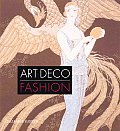
2. valentino
= a fashion house started by Valentino Garavani (1932 - )
Biographical information: At age 17 Valentino Garavani moved to Paris from his town in northern Italy and began his apprenticeship with Jean Desses and Guy Laroche. In 1959 he opened his first fashion house in Rome. One year later he teamed up with Giancarlo Giammetti who is the commercial manager of the house of Valentino. Valentino is an immediate sensation: he is the designer for the world of La Dolce Vita.
In 1968 he designs the wedding dress for Jacqueline Kennedy's marriage to Aristote Onassis catpulting him into the fashion stratosphere. Between then and now he has won every award possible and it is hard to argue that he is not Italy's greatest living designer. Valentino now has a broad fashion empire but the House of Valentino designs one thing: evening gowns. In that he is preeminent. I don't think any designer has more dresses, new or vintage, on the red carpet than Valentino.
A couple ideas for an advertising campaign for vintage Valentino:
Vintage Valentino:
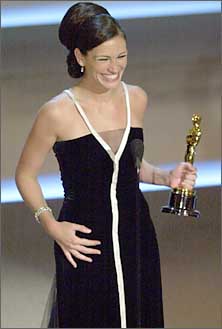
A dress so memorable that they may even forget that the woman wearing it was a blithering idiot.. . .
Vintage Valentino:
After the love is gone, the dress remains.
Valentino has also been known to admonish stars for going out into public looking sloppy -- if not sleazy. He believes that stars have an obligation to their public to be glamorous:
Italian fashion designer Valentino Garavani slammed Julia Roberts and Cameron Diaz for their fashion style, claiming they look like 'homeless bag ladies' compared with Hollywood stars from the past.
Valentino, 73, who dresses famous actresses like Gwyneth Paltrow and is often seen on the red carpet with her, declared that celebrities today should always look glamorous, not only when they are invited to parties or award shows.
The designer told German newspaper Die Ziet: "Today you see Julia Roberts and Cameron Diaz running around looking unkempt in jogging trousers, they look like bag ladies, like homeless people. In the past, actresses had to commit in their contracts to appear in public like stars when they left their homes.
a couple of recommended books:
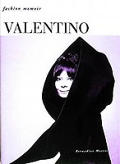
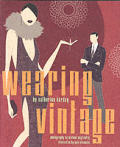
Fashion Memoir: Valentino
3. vamp??
Did this dress remind anyone else of Morticia Addams?? (For the record, I consider the comparison to be a complimentof the highest order.)
 It just seems like the perfect dress for the woman who would say:
It just seems like the perfect dress for the woman who would say:"I'm just like every modern woman trying to have it all. A loving husband, a family. I only wish I had more time to see out the dark forces and join their hellish crusade. " (What a great line. All hail Paul Rudnick.)You also have to appreciate the irony that it was Laura and not Jeffrey who sent the best goth look down the runway.
And forget the bikinis and babydoll looks: that dress' back with its slinky fishtail swish provided the sexiest look in all four shows.


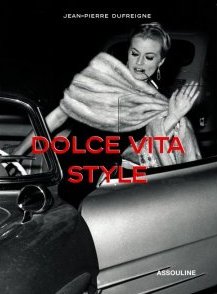

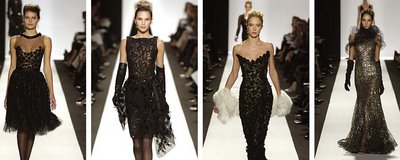

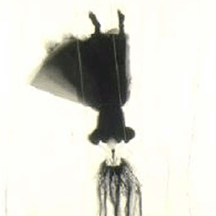









4 comments:
i'm so glad you're back! i kept checking! i haven't even read everything yet, but i had to comment. vionnet's work just always takes my breath away. i first saw it in a book called 'haute couture' by koda and martin. a catalogue of this show: http://www.metmuseum.org/toah/hd/haut/hd_haut.htm
there are a lot more of hers in the book than on the website....
i hadn't made the connection with laura but i really like how you did it.
I wish I'd discovered your blog earlier!
WOW. Thank you for taking the time and effort to present your ideas -- very well done, and I feel like I learned a lot today.
Thanks so much!
You are always spot-on. I love your take. I check in here often just to hear what you have to say.
Bravo.
Newbie
Post a Comment